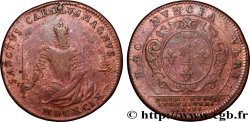fme_897776 - LOUIS-PHILIPPE I Fonte pour l’ouvrage de L. Vivien, retour des cendres de Napoléon Ier
60.00 €
Количество
Добавить в корзину

Тип Fonte pour l’ouvrage de L. Vivien, retour des cendres de Napoléon Ier
Дата: 1844
Монетный двор / Город: 75 - Paris
Металл: alloy
Диаметр: 61,5 mm
Ориентация осей монеты: 12 h.
Гравер MONTAGNY Jean-Pierre (1789-1862)
Вес: 79,76 g.
Век: irrégulier
Пуансон: sans poinçon
Комментарии о состоянии
Patine hétérogène. Tranche irrégulière avec des coulures de métal particulièrement présentes, notamment à 6 heures
Ссылки в каталоге: :
Лицевая сторона
Аверс: легенда: HIST. DE LA RÉVOLUTION, DE L’EMPIRE, DE LA RESTAURATION ET DE LA MON. DE 1830. // PUBLIÉ PAR POURRAT FRÈRES / A PARIS.
Аверс: описание: Tête laurée de Napoléon Ier à droite.
Обратная сторона
Реверс: легенда: ANÉPIGRAPHE.
Реверс: Описание: L'arrivée des cendres de Napoléon Ier aux Invalides, le cercueil de Napoléon Ier est porté par ses fidèles ; au centre, la France, tenant une branche de laurier et une branche d'olivier, les reçoit; un angelot tient le chiffre N sur un autel ; derrière, les Invalides et au loin la Belle-Poule; le tout sous un aigle portant Napoléon radié. Signé : MONTAGNY.
Комментарий
Diamètre sans bélière : 55 mm
L'ouvrage de L. Vivien, Histoire générale de la Révolution française, de l'Empire, de la restauration, de la Monarchie de 1830 est édité par Pourrat frères en 1844. Cette médaille était certainement une médaille publicitaire commandée par les éditions Pourrat Frères..
Diameter without bail: 55 mm The work of L. Vivien, General History of the French Revolution, the Empire, the Restoration, the Monarchy of 1830 was published by Pourrat frères in 1844. This medal was certainly an advertising medal ordered by the Pourrat Frères editions.
L'ouvrage de L. Vivien, Histoire générale de la Révolution française, de l'Empire, de la restauration, de la Monarchie de 1830 est édité par Pourrat frères en 1844. Cette médaille était certainement une médaille publicitaire commandée par les éditions Pourrat Frères..
Diameter without bail: 55 mm The work of L. Vivien, General History of the French Revolution, the Empire, the Restoration, the Monarchy of 1830 was published by Pourrat frères in 1844. This medal was certainly an advertising medal ordered by the Pourrat Frères editions.








 Cообщить об ошибке
Cообщить об ошибке Распечатать страницу
Распечатать страницу Отправить мой выбор
Отправить мой выбор Задать вопрос
Задать вопрос Consign / sell
Consign / sell
 Информация
Информация















